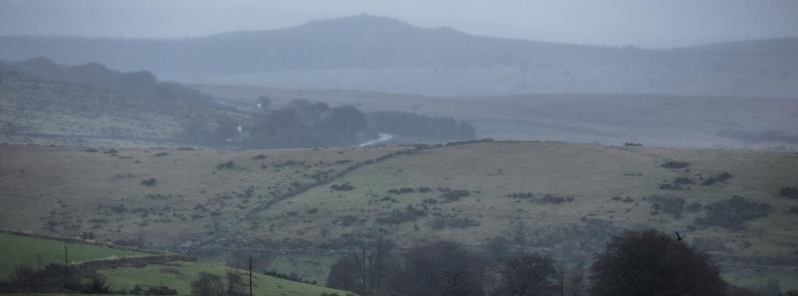Future rainfall in UK uplands heavier than present climate predictions, study suggests

Uplands in the UK could see significantly more annual rainfall in the future than what is currently being predicted in national climate models, according to a new study conducted by University of Plymouth research student, Thomas Murphy, along with academics from the School of Geography, Earth and Environmental Science and School of Biological and Marine Sciences.
The researchers examined rainfall records from the 1870s up to the present day, comparing them against those featured in the Met Office's UK Climate Projections 2018 (UKC18) report.
Results show that there has been a notable increase in spring, autumn, and winter precipitation– the greatest being in upland windward areas of the region, with winter increases widely consistent with UKCP18 projections.
However, the findings for spring, summer, and autumn precipitation show there could be huge divergence by the mid to late 21st century, with the examined mismatch most significant in uplands.
"Our study helps to contextualize the latest UK climate change projections, and suggest caution is required when making assumptions on climate impacts based on climate models. Current models predict that by 2050, summer rainfall on Dartmoor will fall by as much as 20%, but our results from past records show that in the uplands it is on an upward trajectory," said Dr. Paul Lunt, Associate Professor in Environmental Science and also one of the research authors.
He added, "This study shows there have been significant increases in spring, autumn, winter and annual precipitation for upland regions in South West England between 1879 and 2012. Meanwhile, the moderate increases in summer precipitation represent a deviation from the drier summers predicted within current and previous climate models."
Lunt explained that the research highlights the complex challenges facing those attempting to predict the effects of climate change.
"Upland areas are among the most important UK regions in terms of biodiversity and carbon sequestration, but they are also the most vulnerable to increased precipitation."
Upland areas over 300 m (984 feet) above sea level cover around a third of the land area in the UK, and are also considered of national and international significance due to the site's biodiversity and cultural heritage.
Furthermore, the uplands are the source of 68% of the country's freshwater. It also plays an important role in mitigating flood threats.
Precipitation levels in the uplands are usually twice the average of those for the lowlands. As a result, their impact on flooding risk and downstream flood damage is disproportion to the catchment area.
The study aims to scrutinize one of the longest-running upland and lowland precipitation records anywhere in Western Europe, the authors said, focusing on Dartmoor and Plymouth.
In conclusion, the findings show that rainfall in upland areas has increased in all seasons– with spring, autumn, and winter increasing by over 12%– over the past 130 years. In Plymouth, rainfall has increased by over 5% in all seasons except for summer, where there has been a slight drop. Yearly levels in the uplands and Plymouth have shot up by 11% and 5% respectively over the same period.
The authors said while the findings are important at a local scale, they are also relevant for upland coastal sites across the North-East Atlantic.
Reference:
"Taking the higher ground: deviation between projected and observed precipitation trends varies with altitude" – Murphy, T. R. et al – Climate Research – DOI: 10.3354/cr01583
Abstract
Variation in the amount and intensity of precipitation is one of the most important factors determining how biological systems respond to anthropogenic climate change. Moreover, given the importance of climate projections for influencing (inter)national policy, there is a pressing need to contextualise contemporary projections with observed trends to better inform environmental strategy and planning. In this study we examine trends from one of the longest paired time series of upland (>300m) and lowland precipitation records (1879–2012), and shorter-term observations (1961–2015) from multiple upland locations in South West (SW) England (Dartmoor National Park). In the period 1879–2012, total precipitation in the upland site increased by more than 10% for spring, autumn, winter, and annually; for the lowland site, only spring experienced a significant increase (8%) in precipitation. Increases in autumn, winter and annual precipitation were recorded at upland sites since the 1960s. We compare observed precipitation trends with the latest UK climate projections (UKCP18) for the region across two timeframes (60 and 90 years). Changes in the 30 year average between reference (1981–2010) and observed and projected precipitation totals were compared and deviations calculated. Comparisons between model projections and observed trends show large deviation for spring, summer and autumn precipitation in the mid to late 21st century, with the deviation greatest in upland localities. Winter projections however, were broadly consistent with observed trends. Results suggest uncertainties in future precipitation change are greatest in the uplands where the impacts on ecosystem services are the largest.
Featured image credit: Lloyd Russel/University of Plymouth

Commenting rules and guidelines
We value the thoughts and opinions of our readers and welcome healthy discussions on our website. In order to maintain a respectful and positive community, we ask that all commenters follow these rules.